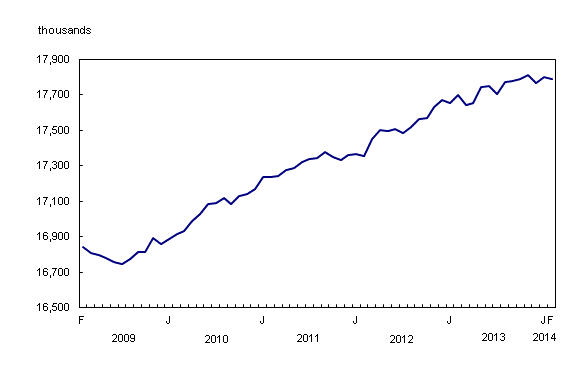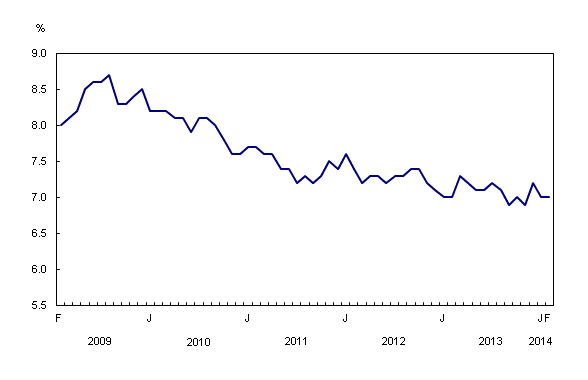Labour Force Survey, February 2014
Archived Content
Information identified as archived is provided for reference, research or recordkeeping purposes. It is not subject to the Government of Canada Web Standards and has not been altered or updated since it was archived. Please "contact us" to request a format other than those available.
Released: 2014-03-07
Employment was little changed in February, and the unemployment rate remained at 7.0%. There has been little overall employment growth in Canada since August 2013.
Compared with 12 months earlier, employment increased by 95,000 (+0.5%) and the unemployment rate was unchanged. Over the same period, the number of hours worked rose 0.7%.
Provincially, employment decreased in Quebec and British Columbia, while it increased in Alberta and Nova Scotia.
In February, there were fewer people working in health care and social assistance as well as finance, insurance, real estate and leasing. At the same time, employment rose in "other services," natural resources as well as agriculture.
The number of public sector employees declined in February, while there was little change among private sector employees and the self-employed.
Employment fell among men aged 25 to 54 and was virtually unchanged for the other demographic groups.
Provincial employment
In Quebec, the number of people working fell by 26,000 in February, pushing the unemployment rate up 0.3 percentage points to 7.8%. This employment decline follows a slight upward trend that began in September 2013.
In British Columbia, 10,000 fewer people were employed in February. The unemployment rate for this province was 6.4%, unchanged from a month earlier, as fewer people participated in the labour market. Compared with 12 months earlier, employment in British Columbia was essentially unchanged.
Employment in Alberta rose by 19,000 in February, pushing the unemployment rate down 0.3 percentage points to 4.3%. On a year-over-year basis, employment in this province grew by 3.8% or 82,000, accounting for the lion's share of the national growth.
In February, employment increased by 2,900 in Nova Scotia. The unemployment rate was little changed at 8.9% compared with the previous month, as more people entered the labour market. Compared with February 2013, employment in the province was little changed.
Although employment in Saskatchewan was little changed in February, the unemployment rate fell 0.4 percentage points to 3.9%, as fewer people searched for work. On a year-over-year basis, employment in the province increased 0.9% or 5,200.
Industry perspective
Employment in health care and social assistance fell by 28,000 in February. Despite this decline, employment in this industry has been on a slight upward trend since August.
There were 25,000 fewer people working in finance, insurance, real estate and leasing in February, the first notable decline in this industry since an upward trend began in September.
In February, employment rose by 18,000 in "other services" such as personal care services as well as civic and social organizations. Compared with a year earlier, however, employment in this industry was unchanged.
There were 9,800 more people working in natural resources in February. On a year-over-year basis, employment in this industry was up 9.6% or 34,000.
Employment in agriculture increased by 7,900 but was little changed compared with 12 months earlier.
In February, the number of public sector employees fell by 51,000, with declines in health care and social assistance, educational services as well as transportation and warehousing. On a year-over-year basis, there was little change in the public sector and in self-employment, while the number of private sector employees increased by 129,000 (+1.1%).
Employment declines among men aged 25 to 54
There were 20,000 fewer men aged 25 to 54 working in February, bringing employment to virtually the same level as that of 12 months earlier. Among women in this age group, there was little change in employment in February compared with the previous month and with a year earlier.
Employment was little changed among youths aged 15 to 24 in February compared with a month earlier, but was down 36,000 (-1.5%) from 12 months earlier. The youth unemployment rate was 13.6%, unchanged from a year earlier.
There was no notable employment change among men and women aged 55 and over compared with the previous month. However, employment for this group has been on an upward trend, rising 3.8% (+125,000) since February 2013, mostly the result of population ageing.
Note to readers
The Labour Force Survey (LFS) estimates are based on a sample and are therefore subject to sampling variability. As a result, monthly estimates will show more variability than trends observed over longer time periods. Estimates for smaller geographic areas or industries also have more variability. For an explanation of sampling variability of estimates and how to use standard errors to assess this variability, consult the "Data quality" section of the publication Labour Force Information (Catalogue number71-001-X).
This analysis focuses on differences between estimates that are statistically significant at the 68% confidence level.
The employment rate is the number of employed persons as a percentage of the population 15 years of age and over. The rate for a particular group (for example, youths aged 15 to 24) is the number employed in that group as a percentage of the population for that group.
The unemployment rate is the number unemployed as a percentage of the labour force (employed and unemployed).
The participation rate is the number of employed and unemployed as a percentage of the population. For more detailed information, see the Guide to the Labour Force Survey (Catalogue number71-543-G).
Unless otherwise stated, this release presents seasonally adjusted estimates, which facilitates comparisons by removing the effects of seasonal variations. For more information on seasonal adjustment, see "Seasonal adjustment and identifying economic trends."
Each year, the LFS estimates are revised for the previous three years, using the latest seasonal factors.
A more detailed summary, Labour Force Information (Catalogue number71-001-X), is now available online for the week ending February 15. From the Browse by key resource module of our website under Publications, choose All subjects, then Labour.
Data tables are also now available online. From the Browse by subject module of our website, choose Labour.
The next release of the Labour Force Survey will be on April 4.
Contact information
For more information, contact us (toll-free 1-800-263-1136; 514-283-8300; infostats@statcan.gc.ca).
To enquire about the concepts, methods or data quality of this release, contact Vincent Ferrao au 613-951-4750 (vincent.ferrao@statcan.gc.ca) or Andrew Fields (613-951-3551; andrew.fields@statcan.gc.ca), Labour Statistics Division.
- Date modified:



